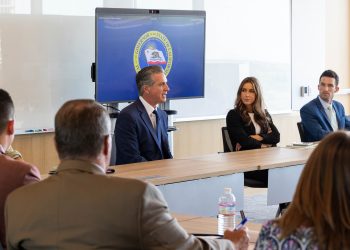If there’s such a thing as a sure thing it politics, it is this: If the water plan announced late last month by Gov. Jerry Brown ever passes the state Legislature, it will surely become the object of a statewide referendum much like the 1982 vote that defeated a somewhat similar plan endorsed by Brown.
The defeat of that plan made consideration of water conveyance plans political anathema for almost 30 years. It was known as the Peripheral Canal because it would have taken many thousands of acre-feet of Sacramento River water yearly around the edges of the delta formed where that river and the San Joaquin River come together east of San Francisco Bay.
But give Arnold Schwarzenegger credit: During the last two years of his tenure as governor, he became the first significant California politician in a generation to seriously consider something similar.
Brown than picked up on that as part of his declared determination to “get s— done” during his second go-‘round as the state’s nominal leader.
Make no mistake, something is needed in the Delta, both to assure water supplies for California’s most significant farms and largest cities, and to preserve water quality and life itself in much of the Delta.
Sure, Brown could okay the tunnels on his own, by executive action with approval from all state and federal wildlife agencies. But nothing this big will ever happen without legislative and voter approval. California is not a dictatorship.
Chances are the yellow-and-black signs that sprouted over the last five years of relative drought along major highways in Central California – the ones that said “Congress-Created Dust Bowl” – probably would never have appeared if there were a Peripheral Canal.
With a canal, there would have been plenty of water both to take care of endangered species like the Delta smelt and to provide water for farms and cities. Without one, it becomes convenient to blame pro-environment politicians whenever water shipments to agriculture are curtailed.
It took the closest thing America has seen to a Communist plebiscite to beat back the Peripheral Canal plan in 1982. While the referendum to cancel it lost by about a 60-40 margin in Southern California, everywhere from Bakersfield north the vote approximated 90 percent in favor of dumping the plan, for an overall 63-37 percent vote against the canal.
Surprisingly, that meant counties like Santa Clara and Contra Costa, which would have been big beneficiaries of the canal, went strongly against it. The issue also cost Brown in his 52-45 percent U.S. Senate race loss to Republican Pete Wilson in 1982.
Ever since those votes, water quality in the Delta has been on the decline, along with the physical condition of levees that make large housing developments possible there.
The main objections to the Peripheral Canal were the same as those now surfacing against the new plan, which would use a $14 billion pair of parallel tunnels – paid for by farmers and other water users – to move as much as half the flow of the Sacramento River 37 miles under the Delta from just south of the city of Sacramento to the giant pumps near Tracy that feed the state Water Project and the Central Valley Project.
It would allow for controlled releases into the Delta to ensure survival of endangered species and diminish salt content when needed. It would take immense pressure off levees that could collapse in a major earthquake and threaten many thousands of lives while also contaminating much of the state’s fresh water.
The new plan would allow substantial flows both to cities and farms even in relatively dry years.
But not all details of the plan (http://baydeltaconservationplan.com/news/news/12-07-25/Governor_Brown_and_Obama_Administration_Outline_Path_Forward_for_BDCP.aspx) are yet clear. Little mention, for one thing, has yet been made of new reservoirs which might be needed to assure steady supplies from year to year.
No one yet knows how much water each type of user will be entitled to each year. No one knows the precise effects all this might have on untapped wild rivers in Northern California. No one even knows just how much water would flow through the tunnels.
All the details will have to be spelled out before this plan has any chance of legislative passage. It’s doomed if anyone can demonstrate it really would be an environmental danger to any of Northern California, where fears of water theft by Central Valley farmers and Southern California cities have been political bugaboos for a century.
Even if all those issues seem nicely resolved, there will still be opposition on general principal, like the Sierra Club’s instant bleat that “We don’t need 19th Century solutions to today’s problems…it’s disappointing…that we have to discuss whether large, expensive tunnels with no environmental safeguards and many harmful effects are the right solution.”
Of course, this project would include plenty of environmental safeguards, but that neither stops nor diminishes panicked, kneejerk hyperbole and its populist influence.
So while the new tunnel plan seems like a good idea and would almost certainly be better than nothing, it’s far from becoming a fact, something Brown probably knows better than anyone else.













